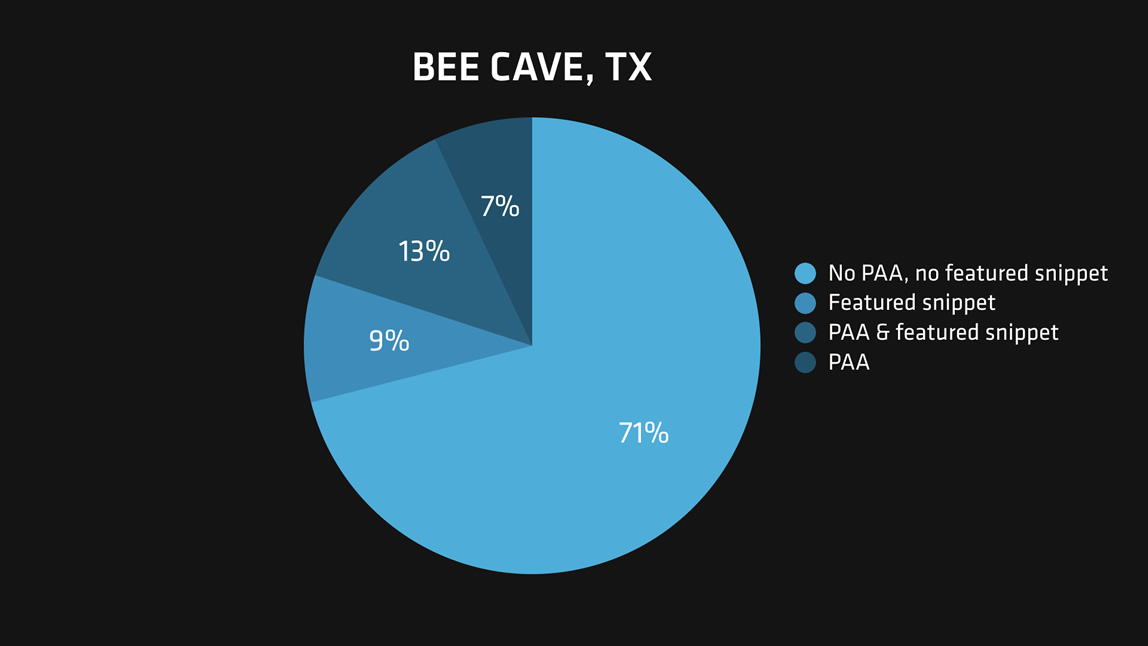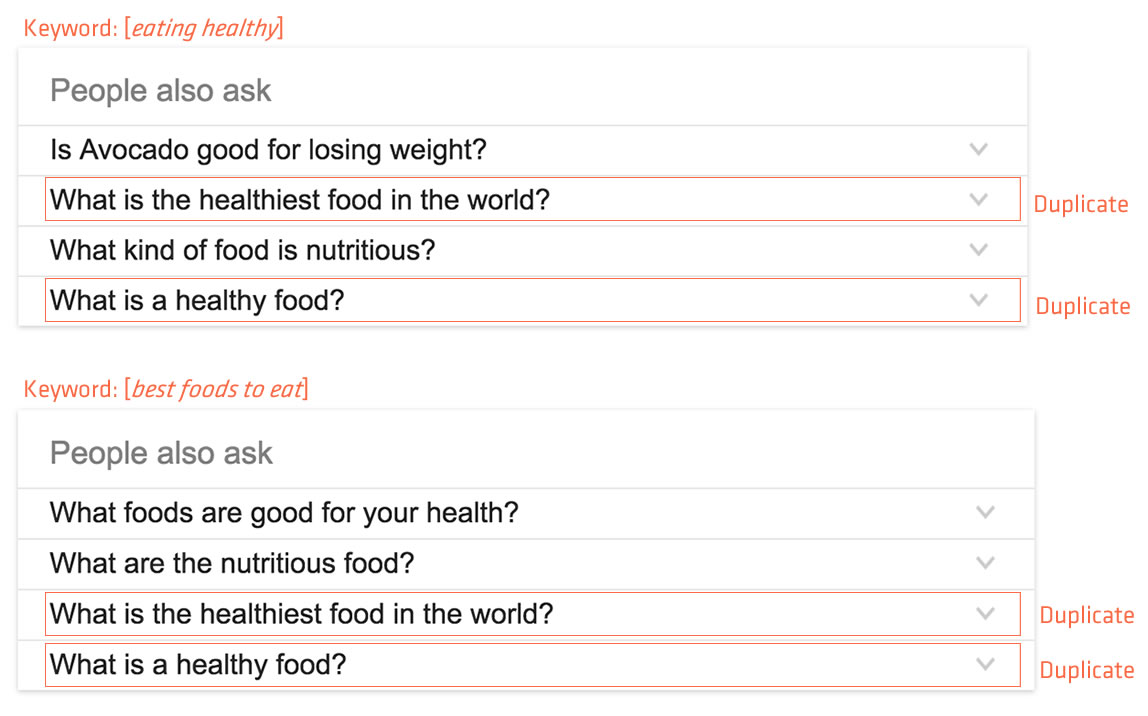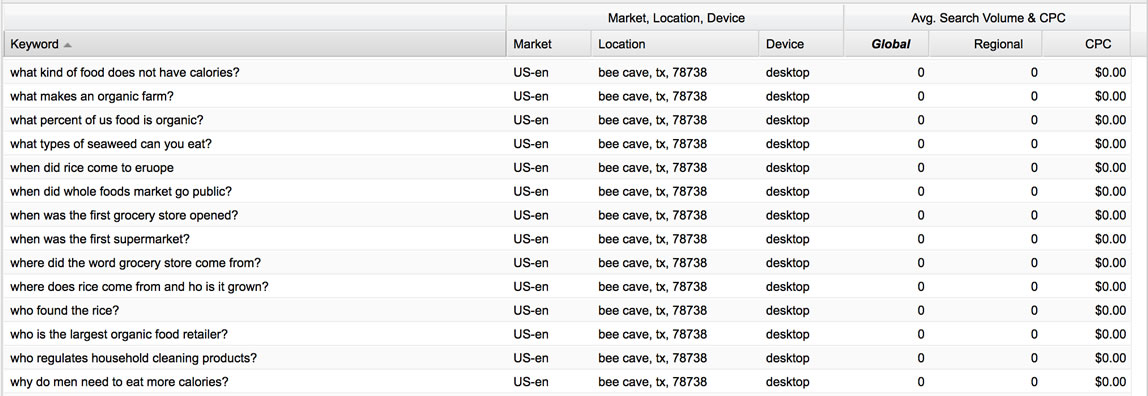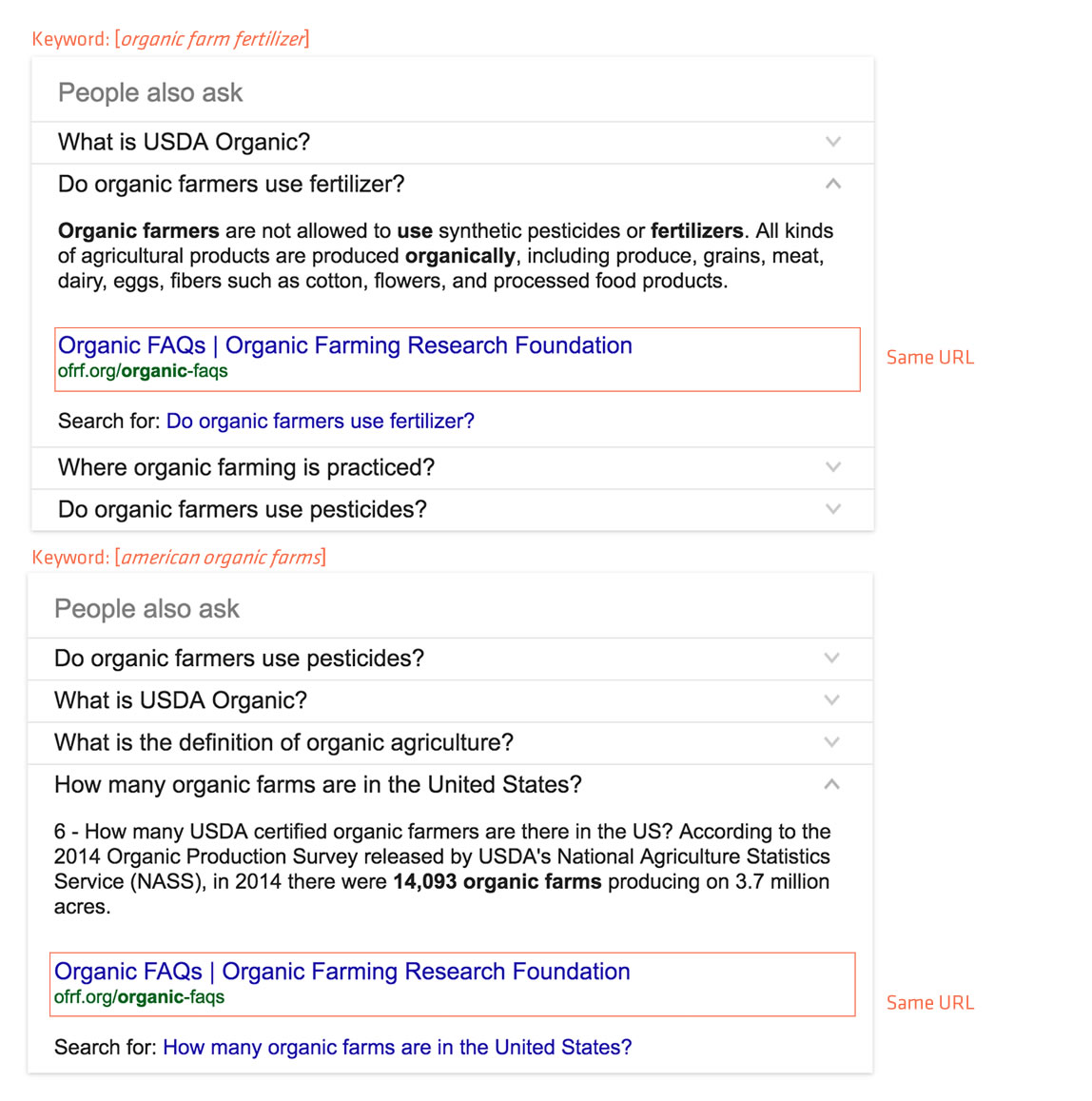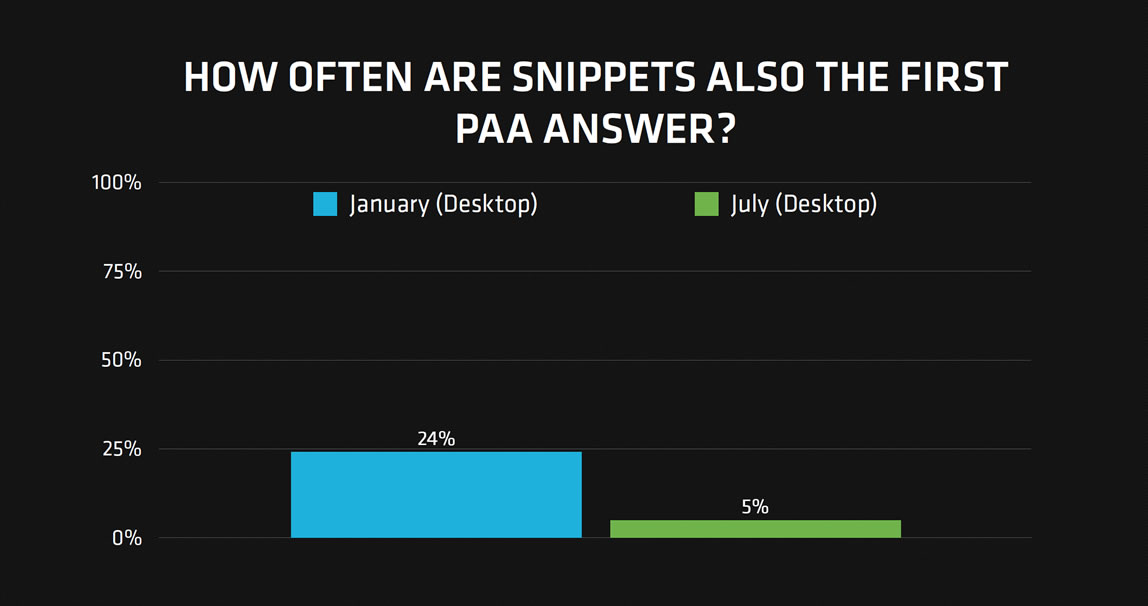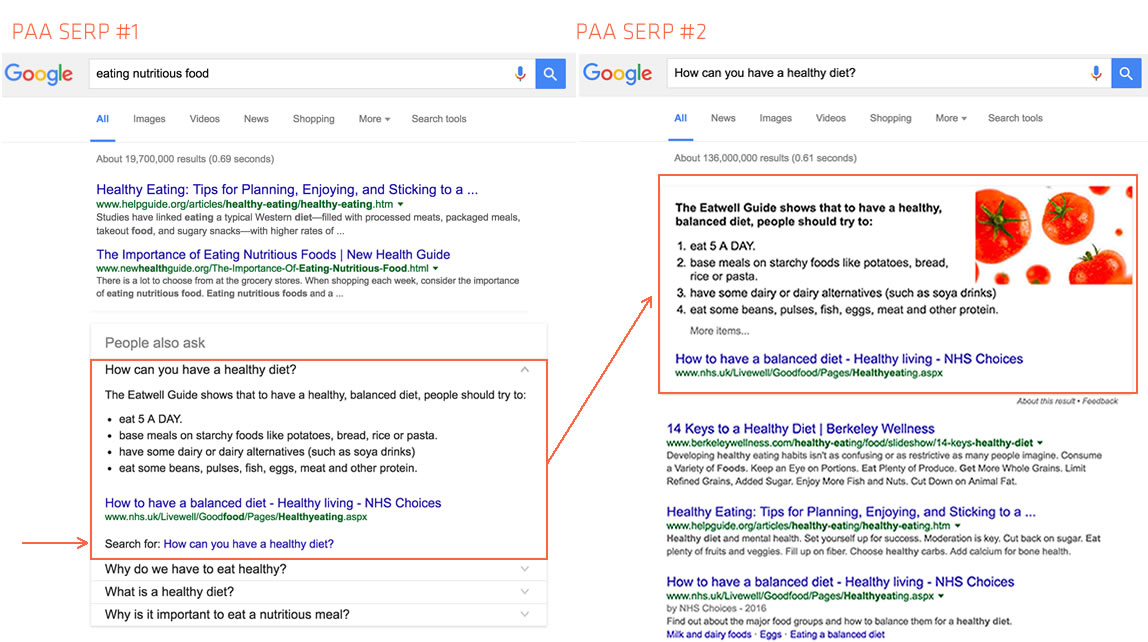We take a closer look at “People also ask” in the hopes of spotting patterns and revealing Google’s master plan for this SERP feature.
*May 25, 2023 update — we did another study on “People also ask” boxes in our post: “People also ask” boxes revisited: what are they up to now?
The “People also ask” (PAA) box is a SERP feature that’s been flying under the radar lately. We’ve chatted a bit about PAAs as how they relate to featured snippets, but thought it was high time they got a little love of their own.
Since we have a bit of a snacking habit here at STAT (did someone say caramel-covered pretzels dipped in chocolate and covered in salt!?), we decided to tackle the topic of PAAs by looking at health food-related keywords so that we could learn about both as we go.
We compiled a list of 894 keywords, like [eating nutritious food] and [healthy snack foods], loaded them into STAT, and tracked them on mobile and desktop SERPs in Bee Cave, Texas — giving us a grand total of 1,788 keywords to explore.
| Full study | Close-up | |
| Total keywords | 1,788 | 50 |
| Desktop & mobile keywords that produced a PAA | 364 | 50 |
| Number of desktop PAA questions | 615 | 195 |
| Number of unique desktop questions | 255 | 96 |
| Number of duplicate desktop questions | 360 | 99 |
Research overview
The breakdown of PAA data points from the full study and 50 keyword close-up.
What is a “People also ask” box?
The “People also ask” box is a Google universal SERP result that answers questions related to the searcher’s initial query. We like to think of it as the cousin of the featured snippet.
Each PAA box contains anywhere from one to four related questions (known as “PAA questions” from here on out), which expand to reveal answers that Google has pulled from other websites. The site’s URL appears below each answer, along with a “Search for” link, which guides the user to a Google SERP of the PAA question.
The anatomy of a PAA
Here are the bits and bobs that make up a PAA for the query [healthy eating].
How often and where do PAAs appear?
In our little study, the “People also ask” box appeared on 20 percent of our Bee Cave SERPs, or on 364 keywords out of 1,788. To get a sense as to whether this is par for course, we tracked the same keywords in two other locations — Golden, Texas and Ottawa, Canada — and found that they had similar occurrence rates (22 and 19 percent respectively). This tells us that PAAs are a fairly big player on the SERP.
Does the quantity of PAA boxes vary by location?
We found that PAA appearances are pretty similar across various locations.
For comparison, our current SERP superstar, featured snippets, appeared on 24 percent of the same Bee Cave searches. And there’s quite the overlap between the two results. Taking a closer look at our 364 SERPs with a PAA, a whopping 66 percent of them also had a featured snippet.
Breakdown of PAAs and featured snippets
We looked at how many PAAs and snippets were on our SERPs.
When it comes to device, “People also ask” boxes don’t appear to play favourites — they showed up 183 times on desktop and 181 times on mobile SERPs.
As for where PAAs sit on the SERP, unlike featured snippets, they seem to move all over the first page. When we zeroed in and closely examined 50 desktop PAAs — which we’ll be looking at for the rest of this piece — we saw that the majority (22 percent) appeared at the bottom of the first SERP.
The next most popular positions were six and nine, which both saw 16 percent of the PAAs. It’s safe to say that “People also ask” boxes prefer the lower half of the SERP, giving searchers an opportunity to explore their results before considering embarking on additional searches.
The full SERP position breakdown looks like:
- 1: 0%
- 2: 10%
- 3: 4%
- 4: 10%
- 5: 10%
- 6: 16%
- 7: 8%
- 8: 4%
- 9: 16%
- 10: 22%
What can the “Q&A”s of PAAs tell us?
Next we wanted to see what insight we could glean from the questions and answers in PAA boxes.
PAA questions
One of the first things we noticed about “People also ask” boxes is that there is a lot of duplication. Google tends to return the exact same PAA questions for queries within a search topic. Looking closely at our 50 health-food keywords, we saw 195 individual PAA questions appear across the SERPs, but only 96 of those were unique — leaving 99 repeat PAA questions.
Our most frequently occurring PAA question was “Is Avocado good for losing weight?” which appeared on 21 different SERPs, followed by “What is the healthiest food in the world?” which appeared on 19.
PAA questions on repeat
Google serves up many of the same PAA questions for related queries.
So, where are these questions coming from? Well, much like how featured snippets come into being, the birthing of a PAA is likely to remain a mystery.
To begin trying to learn their origin story, we first had to ask, are people also asking these questions? To find out, we uploaded the 96 unique PAA questions into STAT and looked at their search volume.
Most of these queries did return varying levels of search volume (“good” or “bad” search volume being incredibly subjective), but we did find that 32 percent returned a global search volume of nadda. Zero. Zip. This seems to suggest that Google is not selecting these questions based on how often they’re searched.
The questions in PAA boxes often have zero search volume
When we stripped the PAA questions out and tracked them in STAT, we saw many with zero search volume.
That said, we can’t rule out the idea that a GoogleBot is doing its darndest to understand actual search queries and spit out relevant subsequent searches.
Errant capitalization or non-capitalization (“Is Spinach heart healthy?”; “Is simple green non toxic?”), wonky grammar (“What is the organic farming?”), and odd follow-up question choices (“Is a MCMUFFIN healthy?” for the keyword [nutrition for men]), suggest that PAA questions are being pulled or generated from somewhere, but that somewhere is still working out the kinks. If you’ve got any research or best guesses, we’d love for you to throw them our way.
PAA answers
Looking at the URLs ranking in “People also ask” boxes, we discovered that Google will almost always cite the same source for a particular PAA question — ie. PAA question/answer combos stick together. We found only three instances in 99 duplicate PAA questions where this wasn’t the case, and a different URL was given.
This means that earning a spot in a PAA box can pay off multiple times. For example, every time “Is Avocado good for losing weight?” appeared as a PAA question (which it did 21 times in this study), the URL healthiestfoods.co.uk/avocados-for-weight-loss would appear as its answer, giving the page 21 SERPs-worth of exposure.
We also checked to see whether a single URL could answer different (yet topical) PAA questions, and found a few occurrences of this. For example, ofrf.org/organic-faqs appears for both, “Do organic farmers use fertilizer?” and “How many organic farms are in the United States?” which is likely because the page exists to answer a number of questions about organic farming.
Winner, winner! Organic chicken dinner!
This page is optimized to answer questions about organic farming, and appears to answer more than one PAA question.
While this is considerably less common than the same question/URL pairing above, it does tell us that when Google finds a trusted source, they like to stick with it. In fact, our data showed that everyone’s first stop for information, Wikipedia, had the highest occurrence of this.
So, if you’re looking to land a spot in a “People also ask” box, one recommendation is similar to how you might snag a featured snippet: approach your topic from a position of authority. Make sure you address potential questions a searcher might have in a clear, concise way — can you picture your copy in a PAA?
How predictable are PAAs?
The “People also ask” box is both fickle and predictable. As we mentioned above, we can say with certainty that a URL answering one PAA question will also appear in a different SERP’s PAA box for the exact same question.
We can also say that keywords that return a PAA once, are likely to return a PAA on subsequent searches. When we Googled our 50 keywords for a second time, all but one produced a PAA again.
| Search 1 | Search 2 | |
| Total keywords | 50 | 50 |
| Number of PAA boxes | 50 | 49 |
| Number of PAA questions | 195 | 179 |
| Number of unique questions | 96 | 89 |
| Number of duplicate questions | 99 | 90 |
PAA stats after the first and second search of a keyword
“People also ask” boxes aren’t the same for a keyword from one search to the next.
What proved to be less predictable about a “People also ask” box, however, was both the order of the questions and the questions themselves.
When we compared the PAA box generated from the first Google search to that of the second, for each of our 50 queries, we saw that:
- 28 percent of our second searches produced a PAA box that shared one question with the first PAA;
- 42 percent produced a box that shared two of the same questions with the first;
- 16 percent shared three;
- 12 percent had all new PAA questions;
- 2 percent of our searches didn’t produce a second PAA box;
and only 15 percent of the 79 reoccurring PAA questions appeared in the exact same position.
Two "People also ask" boxes for the same query show only one shared question
When we compare the PAA questions from our first search to a second, we see a lot of fluctuation.
How are “People also ask” boxes formatted?
To tackle this, we first looked at how the questions in PAA boxes are asked — how are they phrased?
For better representation here, we examined the 255 unique PAA questions generated from our full list of 364 PAAs and found:
| Question marker | Percentage | ||
| Are | 3.9% | ||
| Can | 1.6% | ||
| Do | 2.7% | ||
| How | 18.8% | ||
| Is | 11.8% | ||
| What | 51% | ||
| When | 1.6% | ||
| Where | 2% | ||
| Who | 1.6% | ||
| Why | 5.1% |
PAA question markers
The questions in PAA boxes start most frequently with “what,” “how,” and “is.”
Questions that begin with “what,” “how,” and “is” occur most frequently in PAA boxes, making these the kinds of hypothetical questions you’ll want to focus your content around answering.
Next, we looked at the format of PAA answers — 82 percent presented as a paragraph, and 18 percent were lists. (We have yet to spot table formatting in a PAA, but like the evolution of featured snippet types, never say never.)
So, is the answer to your hypothetical question best given as a paragraph, like a “why” question might, or as a list, like a “how”? By thinking about what information your searcher wants to know and structuring content to make learning most accessible, you’ve got a pretty good chance of getting into one (or more) of these bad boys.
Where does a PAA lead a searcher?
In our original featured snippet study, we saw that on 24 percent of SERPs with both a PAA and a snippet, the first PAA answer was identical to the featured snippet answer.
After refreshing our data in June 2016, we saw that number decrease fairly significantly, and the 50 keywords in our PAA study support this downward trend. None of the 195 PAA answers that were returned matched the featured snippet on their SERP, and only a very small handful of PAA URLs appeared as organic listings elsewhere on the first page.
PAAs are sharing less with snippets
We’re seeing a marked decrease in the number of PAA boxes that share the same first answer as the featured snippet.
But what happens when we follow the “Search for” link to the Google SERP of the PAA question? What do we see on those SERPs? Well, 31% of our PAA answers became the featured snippet on the subsequent SERP. In fact, 85% of the URLs in our “People also ask” boxes were found somewhere on the first page of their corresponding SERP.
What you don’t see, however, when you follow a PAA question to its SERP, are other PAAs. After clicking on each of the “Search for” links, not a single PAA box was found on any of the SERPs.
PAAs don't lead you to more PAAs
When you click on the “Search for” link in a PAA, you won’t see another PAA.
As far as we can tell, the click-trail of the “People also ask” box only goes one SERP deep. This behaviour is unlike the “Searches related to” section at the bottom of the SERP, which appears to take you down an infinite SERP path, and gives more weight to the finite nature of PAA expressed above.
Wrap-up and key takeaways
So what have we learned about “People also ask”?
That they’re a pretty big deal, appearing on 20 percent of the SERPs we examined; that they show up equally on desktop and mobile devices; they almost always pair the same answer with the same PAA question; and frequently repeat those PAA questions. Altogether, this makes earning a spot in a PAA box a lucrative strategy for SERP exposure.
We also learned that “People also ask” boxes are a great resource for content inspiration. Looking at the various ways that PAAs express the same basic question can provide you with new ways to expand upon current topics. For example, one piece of content could easily be the answer to PAA questions like, “How do you eat healthy?” and “How do I eat well?”
And finally, we learned that we have a lot more questions to answer about PAAs — so we’re going to continue tracking this result type in STAT and report back if we find anything interesting!
If you’re a STAT client and interested in what’s going down with your own PAAs, email ClientSuccess@getSTAT.com and they’ll help you get sorted.


